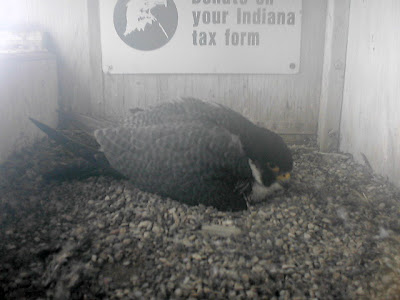








 We are all very anxious to watch hatching of these 4 beautiful eggs from this so very special peregrine couple. SW and Buckeye are a very succesfull pair. SW took over theis Terminal Tower nestsite in 2002 when she killed the resident female Zenith in a territorial fight.
We are all very anxious to watch hatching of these 4 beautiful eggs from this so very special peregrine couple. SW and Buckeye are a very succesfull pair. SW took over theis Terminal Tower nestsite in 2002 when she killed the resident female Zenith in a territorial fight.



 Here the two peregrines are going in to the last week of incubation. Calculating the hatchday is tricky but we know that incubation takes 33 days from the moment incubation really starts.
Here the two peregrines are going in to the last week of incubation. Calculating the hatchday is tricky but we know that incubation takes 33 days from the moment incubation really starts.







 The 5.2 earthquake that hit the Midwest this morning (4/18) did not seem to disturb the birds. Reports on TV and the Indianapolis Star said buildings in downtown Indianapolis shook but if the rattling effect of the helicopter last weekend didn't move them, this earthquake wasn't going to oust them either!
The 5.2 earthquake that hit the Midwest this morning (4/18) did not seem to disturb the birds. Reports on TV and the Indianapolis Star said buildings in downtown Indianapolis shook but if the rattling effect of the helicopter last weekend didn't move them, this earthquake wasn't going to oust them either! 

 Tomorrow it will be 33 days after the last egg has been laid, so we expect the first eyas to make it's great excape some time tomorrow.
Tomorrow it will be 33 days after the last egg has been laid, so we expect the first eyas to make it's great excape some time tomorrow.


 16 days old are these two and watch them excersising their wings. It is a kind of body building their flapping their wings.
16 days old are these two and watch them excersising their wings. It is a kind of body building their flapping their wings.


" We need another, and a wiser, perhaps a more mystical,
concept of animals.
Remote from universal nature and living by complicated artifice,
man in civilization surveys the creature through the glass of his knowledge
and sees thereby a feather magnified and the whole image in distortion.
*
We patronize them for their incompleteness,
for their tragic fate of having taken form so far below ourselves.
And therein we err, and greatly err.
For the animal shall not be measured by man.
*
In a world older and more complete than ours
they move finished and complete,
gifted with extensions of the senses we have lost or never attained,
living by voices we shall never hear.
*
They are not brethren.
They are not underlings.
They are other nations, caught with ourselves in the net of life and time,
fellow prisoners of the splendor and travail of the earth.”
*
Henry Beston




With special thanks to:
Chris & Chad Saladin
